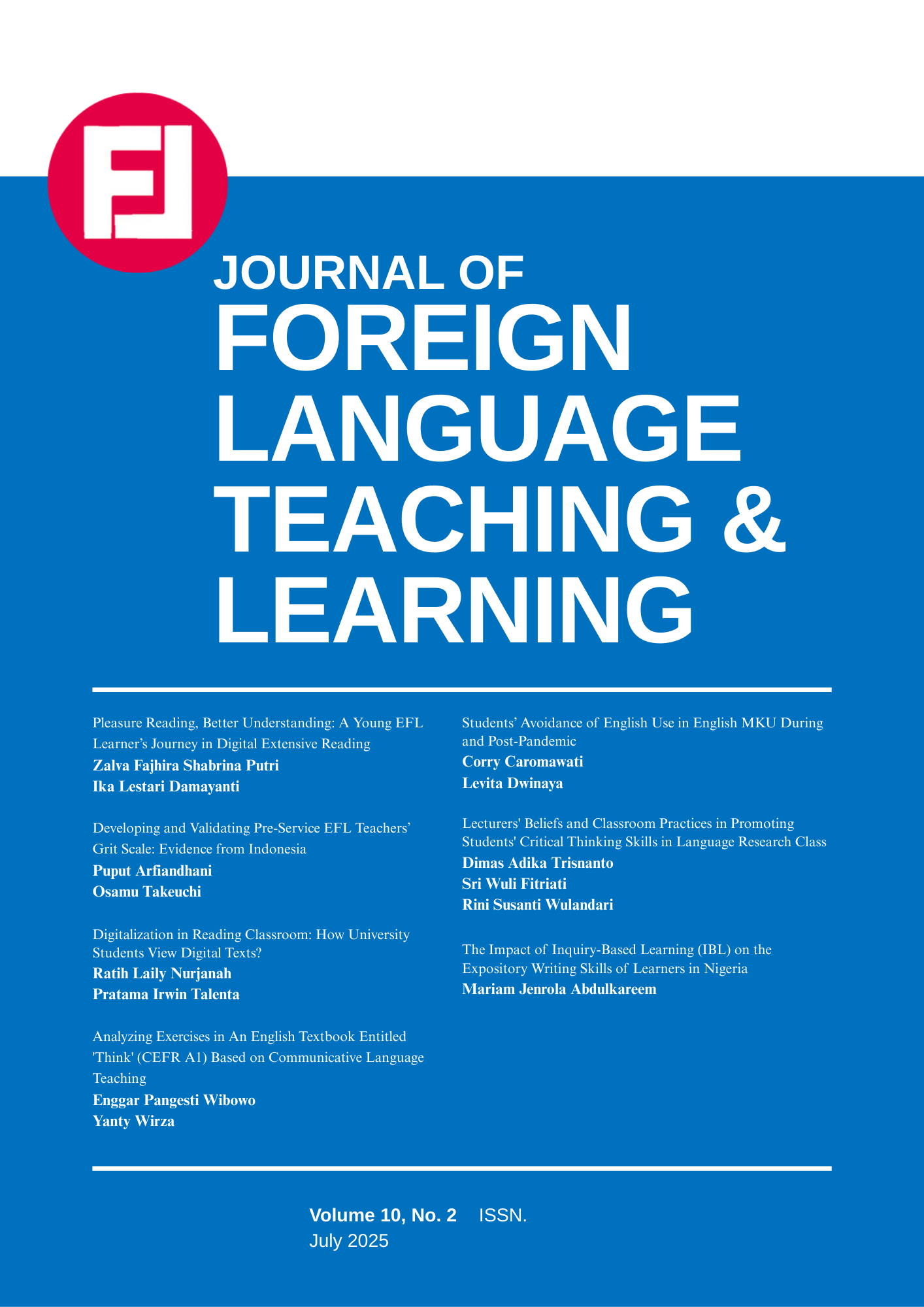Pleasure Reading, Better Understanding: A Young EFL Learner’s Journey in Digital Extensive Reading
DOI:
https://doi.org/10.18196/ftl.v10i2.25269Keywords:
extensive reading, reading for pleasure, young EFL learnerAbstract
Background: The struggle of a young English as a foreign language (EFL) learner in the midst of advanced technology to find pleasure and develop good comprehension in reading English materials necessitates the need to employ effective approaches in their reading experience.
Objective: This study investigated the implementation of digital extensive reading (DER) with a young EFL learner in Indonesia, exploring which established principles of extensive reading (ER) by Day and Bamford (1998) could be utilized in a digital context to foster reading for pleasure and comprehension.
Methods: This study employed a qualitative case study research design involving a seven-year-old young EFL learner in Indonesia. The data were obtained through multiple sources, including a learner diary, audio-recorded observations of ten DER sessions, and an interview with the learner’s father. The data were analyzed using thematic analysis, referencing Day and Bamford’s (1998) top ten principles of ER.
Findings: The findings revealed that eight ER principles could be effectively implemented in the young EFL learner’s DER experience, showcasing the learner’s positive attitudes towards reading and enhanced reading comprehension.
Conclusion: Considering the result, the study recommends future studies to dig deeper into the effectiveness of DER across diverse learners by taking into account factors such as different ages, language proficiencies, learning styles, and technology access.
References
Abdul Rahman, S. H., & Mohamad, M. (2023). Extensive reading to promote ESL learners’ reading motivation: A literature review. International Journal of Academic Research in Progressive Education and Development, 12(2). https://doi.org/10.6007/ijarped/v12-i2/17625
Anggia, H., & Habók, A. (2024). University students’ metacognitive awareness of reading strategies (MARS) in online reading and MARS’ role in their English reading comprehension. PLoS ONE, 19(11). https://doi.org/10.1371/journal.pone.0313254
Apriliyanti, D. L., & Ahmad Munir. (2024). New ways for doing extensive reading: Hyperlearning and cultural context. Tell : Teaching of English Language and Literature Journal, 12(2). https://doi.org/10.30651/tell.v12i2.23393
Astutik, Y. P. (2022). Students’ Perception of Extensive reading e-book as technology-based applications in online English language classroom. PEEL: Journal English Education and Linguistic, 1. https://doi.org/https://doi.org/10.56489/peel.v1i1.70
Aydawati, E. N., Sujarwati, I., Syamsiah, N., Annury, M. N., Mariam, S., Kepirianto, C., Suranto, Fridolini, Tarwiyah, S., & Sutrisno, D. (2025). Integrating extensive reading strategy training with innovative technologies: fsQCA on EFL learner autonomy and vocabulary acquisition. Forum for Linguistic Studies, 7(1), 847–866. https://doi.org/10.30564/fls.v7i1.8021
B. Britania, Ma. C., & A. Acosta, Dr. N. A. (2024). Exploring the impact of metacognitive awareness instruction on secondary students’ reading comprehension proficiency. International Journal of Social Science and Human Research, 07(12). https://doi.org/10.47191/ijsshr/v7-i12-87
Bala, A. (2022). The attitudes of EFL students towards extensive reading program in digital library in private primary school (A case of Erbil). International Journal of Social Sciences & Educational Studies, 9(1). https://doi.org/10.23918/ijsses.v9i1p383
Basri, & Basikin. (2024). Exploring undergraduate students’ perceptions toward extensive reading course. Formosa Journal of Sustainable Research, 3(8), 1703–1712. https://doi.org/10.55927/fjsr.v3i8.10957
Becker, M., McElvany, N., & Kortenbruck, M. (2010). Intrinsic and extrinsic reading motivation as predictors of reading literacy: A longitudinal study. Journal of Educational Psychology, 102(4), 773–785. https://doi.org/10.1037/a0020084
Birketveit, A., & Rimmereide, H. E. (2017). Using authentic picture books and illustrated books to improve L2 writing among 11-year-olds. Language Learning Journal, 45(1), 100–116. https://doi.org/10.1080/09571736.2013.833280
Birketveit, A., Rimmereide, H. E., Bader, M., & Fisher, L. (2018). Extensive reading in primary school EFL. Acta Didactica Norge, 12(2), 9. https://doi.org/10.5617/adno.5643
Bolhan, N. S., & Ismail, H. H. (2024). Extensive reading and solving reading difficulties among English language learners. International Journal of Academic Research in Business and Social Sciences, 14(12). https://doi.org/10.6007/IJARBSS/v14-i12/24424
Brewster, J., Ellis, G., & Girard, D. (2007). The primary English teacher’s guide. Pearson Elt.
Bui, T. N., & Macalister, J. (2021). Online extensive reading in an EFL context: Investigating reading fluency and perceptions. 33(1). https://doi.org/10125/67391
Burnett, C., & Merchant, G. (2018). New media in the classroom: Rethinking primary literacy. SAGE.
Cahyati, P., & Madya, S. (2019). Teaching English in primary schools: Benefits and challenges. Advances in Social Science, Education and Humanities Research, 326. https://doi.org/https://doi.org/10.2991/iccie-18.2019.68
Chen, S., Zhao, J., de Ruiter, L., Zhou, J., & Huang, J. (2022). A burden or a boost: The impact of early childhood English learning experience on lower elementary English and Chinese achievement. International Journal of Bilingual Education and Bilingualism, 25(4), 1212–1229. https://doi.org/10.1080/13670050.2020.1749230
Collins, V. J., Dargan, I. W., Walsh, R. L., & Merga, M. K. (2022). Teachers’ perceptions of the benefits and challenges of a whole-school reading for pleasure program. Issues in Educational Research, 32(1), 89–104. https://www.researchgate.net/publication/359056957
Creswell, J. W., & Poth, C. N. (2018). Qualitative inquiry and research design choosing among five approaches (4th ed.). SAGE Publications, Inc.
Day, R., & Bamford, J. (2002). Top Ten Principles for Teaching Extensive Reading. Reading in a Foreign Language, 14(2).
Day, R. R. (2015). Extending extensive reading. 27(2). http://nflrc.hawaii.edu/rfl
Day, R. R., & Harsch, K. (2008). Cover to cover (Book 2). Oxford University Press.
Endris, A. A. (2018). Effects of extensive reading on Ethiopian EFL students’ reading comprehension and perceptions. Extensive Reading World Congress Proceedings, 236–244.
Ermerawati, A. B. (2019). The application of Let’s Read! in extensive reading class: Integrating MALL and task-based learning. Mimbar Sekolah Dasar, 6(3), 317–329. https://doi.org/10.17509/mimbar-sd.v6i3.20870
Escudero, I., Fuertes, N., & López, L. (2018). Paraphrasing strategy in EFL Ecuadorian B1 students and implications on reading comprehension. English Language Teaching, 12(1), 56. https://doi.org/10.5539/elt.v12n1p56
Fatimah, A. S. (2019). Portraying learner’s autonomy in extensive reading classroom. OKARA: Jurnal Bahasa Dan Sastra, 13(1), 35. https://doi.org/10.19105/ojbs.v13i1.2228
Fazzi, F., Lio, E. Da, & Guzzon, S. (2024). The affordances of extensive digital social reading for the EFL classroom. Analysis of the DigLit book club project. EL.LE, 1. https://doi.org/10.30687/elle/2280-6792/2024/01/002
Fergina, A., Prancisca, S., Aminah, S., Ananda, E., & Ghazy, A. (2024). The effectiveness of extensive reading in improving reading comprehension. Journal of English Education Program, 5(2), 132–143. https://doi.org/10.26418/jeep.v%vi%i.71717
Firda, I. D. L., Widiati, U., Laksmi, E. D., & Hayati, N. (2018). Attitudes toward extensive reading among English teachers of senior high schools. Jurnal Ilmu Pendidikan, 24(1), 1–9. https://doi.org/http://dx.doi.org/10.17977/um048v24i1p1-9
Forster, D. E., & Poulshock, J. (2021). The need for extensive reading in language education. Studies in English and American Literature, 56.
Hague, P. (2020, November 6). The surprising benefits of reading 20 minutes a day. https://specialedresource.com/benefits-of-reading-20-minutes-a-day
Harimurti, K. F., Suryati, N., & Astuti, U. P. (2021). Students’ perspectives in using XReading as an extensive reading platform for higher education students. JoLLA: Journal of Language, Literature, and Arts, 1(12), 1627–1643. https://doi.org/10.17977/um064v1i122021p1627-1643
Harmer, J. (2007). The practice of English language teaching (4th ed.). Pearson Longman.
Hayik, R. (2015). Diverging from traditional paths: Reconstructing fairy tales in the EFL classroom. Diaspora, Indigenous, and Minority Education, 9(4), 221–236. https://doi.org/10.1080/15595692.2015.1044084
Hermini, Supraba, A., & Paldy. (2022). Children’s response towards extensive reading. IDEAS: Journal on English Language Teaching and Learning, Linguistics and Literature, 9(2), 780–791. https://doi.org/10.24256/ideas.v9i2.2388
Hidayati, M., Renandya, W., & Basthomi, Y. (2022). Extensive reading research: What have we learned and what questions remain? Asian Journal of English Language Studies, 10, 1–61. https://doi.org/10.59960/10.a1
Hoblidar, N. S. (2022). Reading in digital era: A study on enhancing reading skills. International Journal of English Literature and Social Sciences, 7(5). https://doi.org/10.22161/ijels
Hopp, H., Vogelbacher, M., Kieseier, T., & Thoma, D. (2019). Bilingual advantages in early foreign language learning: Effects of the minority and the majority language. Learning and Instruction, 61, 99–110. https://doi.org/10.1016/j.learninstruc.2019.02.001
Hu, T. C., Sung, Y. T., Liang, H. H., Chang, T. J., & Chou, Y. T. (2022). Relative roles of grammar knowledge and vocabulary in the reading comprehension of EFL elementary-school learners: Direct, mediating, and form/meaning-distinct effects. Frontiers in Psychology, 13. https://doi.org/10.3389/fpsyg.2022.827007
Huang, Y. C. (2015). Why don’t they do it? A study on the implementation of extensive reading in Taiwan. Cogent Education, 2(1). https://doi.org/10.1080/2331186X.2015.1099187
Istiqlal, N. A., Utami, P. P., & Kartini, D. (2021). Portraying reading log strategy assisting extensive reading activity with webtoon in senior high school. Jurnal Pendidikan Tambusai, 5(3), 7292–7299. https://doi.org/https://doi.org/10.31004/jptam.v5i3.2142
Janah, K. E. N., Retnaningdyah, P., & Mustofa, A. (2022). Digital extensive reading in Indonesia: A critical review. Journal of English Language Teaching and Linguistics, 7(3), 513. https://doi.org/10.21462/jeltl.v7i3.918
Jia, S. (2022). A study on the influence of age on learning effectiveness of English second language learners. Proceedings of the 2022 3rd International Conference on Language, Art and Cultural Exchange (ICLACE). https://doi.org/https://doi.org/10.2991/assehr.k.220706.017
Kepe, M. H., & Weagle, C. (2020). It starts with a Story! towards extensive reading. 12th International Conference on Education and New Learning Technologies, 8718–8731. https://doi.org/10.21125/edulearn.2020.2153
Krashen, S. (2004). The power of reading. Heinemann.
Kucirkova, N., & Cremin, T. (2020). Chidlren reading for pleasure in the digital age. SAGE.
Kusmaryati, S. E. (2020). Teachers’ perspectives of teaching English to young learners (A descriptive study at primary schools in Kudus). ELT Worldwide, 7(2). https://doi.org/https://doi.org/10.26858/eltww.v7i2.9723
Lailiyah, M., & Fitriana, C. L. (2024). From pages to pixels: Unveiling student experiences with digital storytelling in extensive reading classes. International Journal of Education, Language, and Religion, 6(1), 8. https://doi.org/10.35308/ijelr.v6i1.8440
Lestari, S. (2022). Incorporating extensive reading into the curriculum of English teacher education. Journal of English Teaching, Applied Linguistics and Literatures (JETALL), 5. https://doi.org/http://dx.doi.org/10.20527/jetall.v5i2.12872
Leung, C. Y. (2002). Extensive reading and language learning: A diary study of a beginning learner of Japanese. Mason & Krashen, 14(1). http://nflrc.hawaii.edu/rfl
Luthfaturrohmah. (2024). Unveiling students’ learning strategies and barriers to extensive reading: a case study in an Indonesian university. Erudita: Journal of English Language Teaching, 4(1). https://doi.org/10.28918/erudita.v4i1.8519
Macalister, J. (2015). Guidelines or commandments? Reconsidering core principles in extensive reading. Reading in a Foreign Language, 27(1). http://nflrc.hawaii.edu/rfl
Mardasari, D. (2020). Various activities in teaching English for young learners. Holistics Journal, 12(1). https://doi.org/https://doi.org/10.4108/eai.11-11-2020.166957
Martina, F., Syafryadin, S., & Utama, J. A. (2020). The practice of extensive reading among EFL learners in tertiary level. Yavana Bhasha : Journal of English Language Education, 3(2), 56. https://doi.org/10.25078/yb.v3i2.1712
Meniado, J. C. (2016). Metacognitive reading strategies, motivation, and reading comprehension performance of Saudi EFL Students. English Language Teaching, 9(3), 117. https://doi.org/10.5539/elt.v9n3p117
Mikulecky, B. S., & Jeffries, L. (2007). Advanced reading power: Extensive reading, vocabulary building, comprehension skills, reading faster. Longman.
Muchtar, N. (2019). Intensive and extensive reading in improving teaching reading comprehension. Lingua Pedagogia (Journal of English Teaching Studies), 1(2). https://doi.org/http://dx.doi.org/10.21831/lingped.v1i2.18687
Muravev, Y. (2023). Improving second language acquisition by extensive and analytical reading in a digital environment. Journal of College Reading and Learning, 53(1), 3–19. https://doi.org/10.1080/10790195.2022.2084798
Mutiah, S. D., Nakhriyah, M., HR, N. H., Hidayat, D. N., & Hamid, F. (2020). The readiness of teaching English to young learners in Indonesia. Jurnal Basicedu, 4(4), 1370–1387. https://doi.org/10.31004/basicedu.v4i4.541
Nakamura, S. (2018). Effects and impact of extensive reading in Japanese university English for general purposes classes. Studies in Self-Access Learning Journal, 9(1), 3–10. http://sisaljournal.orghttp://sisaljournal.org/archives/mar18/Nakamura
Nakayama, A., & Dickinson, P. (2023). Promoting learner autonomy through extensive reading. The Southeast Asian Conference on Education 2023: Official Conference Proceedings, 527–536. https://doi.org/https://doi.org/10.22492/issn.2435-5240.2023.43
Neisi, L., Hajijalili, M., & Namaziandost, E. (2019). The impact of using inverted classrooms on promoting extensive versus intensive reading comprehension among Iranian upper-intermediate EFL learners. Theory and Practice in Language Studies, 9(12), 1513–1523. https://doi.org/10.17507/tpls.0912.07
Nell, V. (1988). The psychology of reading for pleasure: Needs and gratifications. Reading Research Quarterly, 23(1), 6–50.
Ng, Q. R., Renandya, W. A., & Chong, M. Y. C. (2019). Extensive reading: Theory, research and implementation. Teflin Journal, 30(2), 171.
Nkomo, S. A. (2021). The benefits of an extensive reading programme implemented in two foundation phase classrooms in the Eastern Cape, South Africa. Reading and Writing, 12(1). https://doi.org/10.4102/RW.V12I1.290
Nuttall, C. (2005). Teaching reading skills in a foreign language. Macmillan.
Ostojić, A. B. (2023). Reading comprehension processes: A review based on theoretical models and research methodology. Hrvatska Revija Za Rehabilitacijska Istrazivanja, 59(1), 122–143. https://doi.org/10.31299/hrri.59.1.8
Özdemir, E. Ç., & Akyol, H. (2019). The development of a reading comprehension test. Universal Journal of Educational Research, 7(2), 563–570. https://doi.org/10.13189/ujer.2019.070229
Park, A. Y. (2020). A comparison of the impact of extensive and intensive reading approaches on the reading attitudes of secondary EFL learners. Studies in Second Language Learning and Teaching, 10(2), 337–358. https://doi.org/10.14746/ssllt.2020.10.2.6
Petscher, Y. (2010). A meta-analysis of the relationship between student attitudes towards reading and achievement in reading. Journal of Research in Reading, 33(4), 335–355. https://doi.org/10.1111/j.1467-9817.2009.01418.x
Piaget, J., & Inhelder, B. (1969). The psychology of the child. Basic Books.
Pirih, A. (2019). Extensive reading and changes to reading motivation in EFL among Slovene primary school pupils. Journal of Elementary Education, 12(4), 291–314. https://doi.org/10.18690/rei.12.4.291-314.2019
Prihartono, D., Miftakh, F., & Rachmawati, M. (2021). Engaging extensive reading practice mediated by Let’s Read Asia in online classroom. Journal of Intensive Studies on Language, Literature, Art, and Culture, 5(2), 191–202. https://doi.org/http://dx.doi.org/10.17977/um006v5i22021p191-202
Promluan, Y., & Sukying, A. (2021). The impact of extensive reading on Thai primary school children’s vocabulary knowledge. Journal of Modern Learning Development, 6(5), 209–223.
Ramonda, K. (2020). Extensive reading and class readers: The case for no choice. ELT Journal, 74(3), 277–286. https://doi.org/10.1093/elt/ccaa017
Renandya, W., Hidayati, M., & Ivone, F. (2021). Extensive reading: Top ten implementation issues. JACET Journal, 65, 11–21. https://doi.org/10.32234/jacetjournal.65.0_11
Richards, J. C., & Renandya, W. A. (2002). Methodology in language teaching: An anthology of current practice. Cambridge University Press.
Romdanih, R., & Yuningsih, E. (2021). Integrating fairy tales into reading class: Do they catch young learners’ reading interest? Jurnal Ilmu Pendidikan (JIP) STKIP Kusuma Negara, 12(2), 132–138. https://doi.org/10.37640/jip.v12i2.857
Romina M. Adora, Justine P. Aguilar, Erica Arsua, Ma. Angelica S. Asis, Mark Ivan E. Pereja, Jovelle M. Reyes, & Jan Carlo P. Tolentino. (2024). Reading comprehension and students’ academic performance in English. International Journal of Science and Research Archive, 11(2), 1240–1247. https://doi.org/10.30574/ijsra.2024.11.2.0523
Rosenblatt, L. M. (1982). The literary transaction: Evocation and response. Theory Into Practice, 21(4), 268–277. https://doi.org/10.1080/00405848209543018
Rosmayanti, V., & Yahrif, M. (2023). Best practices in promoting students’ reading habit in extensive reading class. AL-ISHLAH: Jurnal Pendidikan, 15(3). https://doi.org/10.35445/alishlah.v15i3.3432
Saefatu, Y. I., Mustofa, A., & Retnaningdyah, P. (2023). EFL students’ perceptions of digital extensive reading program in junior high school level. 4, 803–812. https://doi.org/https://doi.org/10.62775/edukasia.v4i2.354
Sari Dewi, R., Hasanah, U., & Wahyudi, A. (2020). Talent development and excellence reading interest and reading comprehension. 12(1), 241–250. http://www.iratde.com
Sari, R. K., Erlangga, F., & Kuncoro, A. (2019). Introduction to extensive reading using graded reader books on junior high school students in East Jakarta. Agustus, 23. https://doi.org/10.30998/simponi.v0i0.369
Savitri, W. E., Widiati, U., Suryati, N., & Ivone, F. M. (2024). Extensive reading principles implementation: Pleasure vs pressure. JOLLT Journal of Languages and Language Teaching, 12(2), 895–906. https://doi.org/10.33394/jollt.v%vi%i.10928
Scott, W. A., & Ytreberg, L. H. (1995). Teaching English to children (Longman keys to language teaching) (1st ed.). Allyn & Bacon.
Sheridan, R., & Condon, B. (2020). Letting students choose: How culture influences text selection in EFL reading courses. Journal of Asia TEFL, 17(2), 523–539. https://doi.org/10.18823/asiatefl.2020.17.2.14.523
Sianturi, W. P. F., Sinaga, N. T., & Sidabutar, U. (2024). The effect of students’ metacognitive awareness and reading comprehension in narrative text of second-grade students. Alacrity: Journal of Education, 4(3), 2775–4138.
Sideridis, G. D., Morgan, P., & Simos, P. G. (2013). Introduction to Approaching Reading Comprehension From Multiple Theoretical Perspectives. Reading and Writing Quarterly, 29(2), 121–123. https://doi.org/10.1080/10573569.2013.758559
Song, M. (2020). The impact of extensive reading on EFL primary school students’ vocabulary acquisition and reading comprehension. The 5th World Congress on Extensive Reading.
Thongsan, N. C., & Waring, R. (2024). Challenges in implementing extensive reading in Thailand. REFLections, 31(2), 457–477. https://doi.org/https://doi.org/10.61508/refl.v31i2.274278
Tosun, Z. Y., & Gönen, S. İ. K. (2024). Technology meets extensive reading: Design of a blended extensive reading program in an English as a foreign language context. Proceedings of The International Conference on Research in Teaching and Education, 1(1), 26–37. https://doi.org/10.33422/rteconf.v1i1.241
Vygotsky, L. (1978). Mind in society: The development of higher psychological processes. Harvard University Press.
Wagner, C. J. (2020). Seeing and nurturing young children’s reading identities. Journal of Language and Literacy Education, 16.
Waring, R., & Husna, N. (2019). Expectations and experiences of indonesian teachers who have, and have not, done extensive reading. Teflin Journal, 30(2), 153–170. https://doi.org/10.15639/teflinjournal.v30i2/153-170
Waring, R., & Mclean, S. (2015). Exploration of the core and variable dimensions of extensive reading research and pedagogy. 27(1). http://nflrc.hawaii.edu/rfl
Wulyani, A. N., Widiati, U., & Khoiri, N. El. (2022). Challenges in implementing extensive reading (ER) programs: Voices from English teachers at Indonesian secondary schools. Pegem Egitim ve Ogretim Dergisi, 12(1), 74–83. https://doi.org/10.47750/pegegog.12.01.08
Yin, R. K. (2008). Case study research: Design and methods (applied social research methods) (4th ed.). SAGE Publications, Inc.
Yılmaz, M., Atay, D., & Mustafa, E. R. (2020). The effects of extensive reading on turkish learners’ L2 reading/writing performance and foreign language self-concept. Journal of Asia TEFL, 17(1), 53–69. https://doi.org/10.18823/asiatefl.2020.17.1.4.53
Yulia, M. F. (2018). Extensive reading for Indonesian university students: An alternative framework for implementation. Journal: A Journal on Language and Language Teaching, 21(2). https://doi.org/10.24071/llt.2018.210210
Zheng, H., Miao, X., Dong, Y., & Yuan, D. C. (2023). The relationship between grammatical knowledge and reading comprehension: A meta-analysis. In Frontiers in Psychology (Vol. 14). Frontiers Media S.A. https://doi.org/10.3389/fpsyg.2023.1098568
Downloads
Published
How to Cite
Issue
Section
License
Copyright (c) 2025 Zalva Fajhira Shabrina Putri, Ika Lestari Damayanti

This work is licensed under a Creative Commons Attribution-ShareAlike 4.0 International License.
Copyright
Authors retain copyright and grant the journal right of first publication with the work simultaneously licensed under a Creative Commons Attribution-ShareAlike 4.0 International License that allows others to share the work with an acknowledgment of initial publication in this journal.
Authors are permitted and encouraged to post their work online (e.g., in institutional repositories, social media account, or on their website) after the article getting published in the journal, as it can lead to productive exchanges and earlier and greater citation of published work (See The Effect of Open Access).License
You are free to:
- Share — copy and redistribute the material in any medium or format
- Adapt — remix, transform, and build upon the material for any purpose, even commercially.
Attribution — You must give appropriate credit, provide a link to the license, and indicate if changes were made. You may do so in any reasonable manner, but not in any way that suggests the licensor endorses you or your use.
ShareAlike — If you remix, transform, or build upon the material, you must distribute your contributions under the same license as the original.
- No additional restrictions — You may not apply legal terms or technological measures that legally restrict others from doing anything the license permits.



.png)





